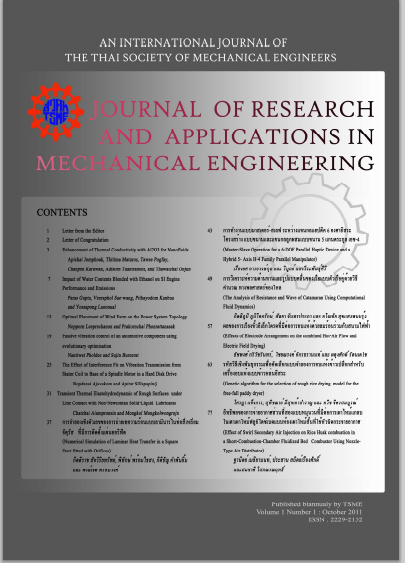Parameter estimation for a mechatronic probe of robot assisted minimally invasive surgery using inverse finite element analysis
Main Article Content
Abstract
There is a need to provide haptic and tactile feedback to surgeons during robot-assisted minimally invasive surgery (RMIS). Such feedback is also essential for palpation based diagnostic during cancer removal using MIS. There have been recent efforts at developing a mechatronic finger to mimic some of the palpation capabilities of a human finger. These mechatronic fingers typically record force-displacement characteristics, in order to infer material properties for diagnostic purposes. This paper presents a non-linear finite element based approach for tissue property identification, based on force-displacement characteristics produced by a mechatronic finger, during mechanical palpations. We use finite element modeling and the Newton- Raphson method to estimate soft tissue parameters. To obtain the ground truth data, a sphere-soft tissue indentation experiment is conducted on a silicone phantom and the sphere-tissue interaction is modeled using finite element software ABAQUSTM. To account for the large deformation behavior of the soft tissue, the Arruda-Boyce hyperelastic model is chosen. Then inverse finite element analysis and the Newton-Raphson method is employed to identify the shear modulus () of the hyperelastic model, employing the static sphere-tissue indentation data as input. The results show that the proposed method can identify soft tissue parameters accurately and robustly with a relatively fast convergence rate. The force-tissue deflection curves predicted by the identified soft tissue parameter are in good agreement with experimental measurements.
Article Details
This work is licensed under a Creative Commons Attribution-NonCommercial-ShareAlike 4.0 International License.
References
Proc. IEEE Int. Conf. Robot. Autom.,ICRA2008.
[2] K. Sangpradit, H. Liu, L. Seneviratne, K. Althoefer, “Tissue Identification using Inverse Finite Element Analysis of Rolling Indentation” Proc. IEEE Int. Conf. Robot. Autom.,
ICRA2009.
[3] A. M. Okamura, C. Simone, and M.D. O’Leary, “Force Modelling for Needle Insertion into Soft Tissue,” IEEE Transactions on Biomedical Engineering, Vol. 51, No. 10, pp.
1707-1716, 2004.
[4] K.H. Fuchs, “Minimially Invasive Surgery”, Endoscopy, 34: 154-159, 2002.
[5] F. Tendick, M.C. Cavusoglu, “Human Machine Interfaces for Minimally Invasive Surgery”, Proc. 19th Intl. Conference IEEE/EMBS, pp 2771-277, 1997.
[6] Southern Surgeons Club, “A prospective Analysis of 1518 Laparoscopic Colecystectomies,” New England Journal of Medicine, Vol. 324, pp 1079-1078, 1991.
[7] S. Phipps, T.H.J. Yang, F.K. Habib, R.L. Reuben and S.A. McNeill, “Measurement of the mechanical characteristics of benign prostatic tissues: A novel method for assessing benign prostatic disease”, Urology 65(5) (2004), 1024–1028.
[8] S. Phipps, T H. J. Yang, F. K. Habib, R. L. Reuben, and S. A. Mcneill, “measurement of tissue mechanical characteristics to distinguish between benign and malignant prostatic diseas urology”, 66: 447–450, 2005.
[9] S. Uranues, H. Maechler, P. Bergmann, St. Huber, G. Hoebarth, J. Pfeifer, B. Rigler, K. -H. Tscheliessnigg, and H. -J. Mischinger, “Early experience with telemanipulative
abdominal and cardiac surgery with the ZeusTM Robotic System”, Euro. Surg., vol. 34, no. 3, pp. 190-193, Jun. 2002.
[10] G. S. Guthart, and J. K. Salisbury Jr., “The IntuitiveTMtelesurgery system: Overview and application”, in Proc. IEEE Int. Conf. Robotics and Automation, 2000, pp. 618-621.
[11] H. A. Tabaie, J. A. Reinbolt, W. P. Graper, T. F. Kelly, and M. A. Connor, “Endoscopic coronary artery bypass graft (ECABG) procedure with robotic assistance”, The Heart
Surgery Forum, vol. 2, no. 4, pp. 310-317, 1999.
[12] D. A. Murphy, J. S. Miller, D. A. Langford, and A. B. Snyder, “Endoscopic robotic mitral valve surgery”, J. Thorac. Cardiovasc. Surg., vol. 132, no. 4, pp. 776-781, Oct. 2006.
[13] Y. Tillier, et al, “Finite element modeling for soft tissue surgery base on nonlinear elasticity behavior”, Excerpta Media International congress series 1268, Elsevier, Amsterdam, 2004, pp. 384-389
[14] Yi liu, A nonlinear finite element model of soft tissue indentation Proceedings of Medical Simulation: International Symposium - ISMS 2004, Cambridge, MA, June 17-18, 2004,
Lecture Notes in Computer Science vol. 3078, Springer- Verlag, pp. 67-76.
[15] Amy E. Kerdok, “Identification of nonlinear constitutive law parameters of breast tissue”, Proceeding of 2005 summer Bioengineering Conference, June 22-26, Vail Cascade Resort & Spa, Vail, Colorado
[16] M. Zhang, Y. P. Zheng, and A. F. T. Mak.“Estimating the effective Young's modulus of soft tissues from indentation tests, nonlinear Finite element analysis of effects of friction
and large deformation”.Medical Engineering andPhysics., vol.19, pages: 512-517, 1997.
[17] E. Tonuk and M. B. Silver-Thorn. “Nonlinear elastic material property estimation of lower extremity residual limb tissues”.IEEE Transactions on NeuralSystems and
Rehabilitation Engineering, vol.11, pages: 43-53, 2003.
[18] G. Picinbono, H. Delingette, and N. Ayache. “Nonlinear anisotropic elasticity for real time surgery simulation”.Graphical Models, vol.65, pages: 305-321, 2003.
[19] Y. Zhong, B. Shirinzadeh, G. Alici, and J. Smith.“A new methodology for deformable object simulation”.IEEE International Conference on Roboticsand Automation, pages:
1902-1907, Barcelona, Spain, 2005.
[20] G. Szekely, Ch. Brechbuhler, R. Hutter, A. Rhomberg, N. Ironmonger, and P. Schmid. “Modelling of soft tissue deformation for laparoscopic surgery simulation”.Medical Image Analysis, vol.4, pages: 57-66, 2000.
[21] J. Schwartz, M. Denninger, D. Rancourt, C. Moisan, and D. Laurendeau.“Modelling liver tissue properties using a nonlinear viscoelastic model for surgery simulation”.Medical
Image Analysis, vol.9, pages: 103-112, 2005.
[22] A. Duysak, J.J. Zhang, and V. Ilankovan.“An Efficient modelling and simulation of soft tissue deformation using mass-spring systems”.International CongressSeries, vol.1256,
pages: 337-342, 2003.
[23] ABAQUS, ABAQUS version 6.8-1 Manual, 2008.
[24] Y. H. Zweiri, L.D. Seneviratne, and K. Althoefer, “Parameter Estimation for Excavator Arm Using Generalized Newton Method,” IEEE Transactions on Robotics.Vol. 20, No.4, pp.762-767. 2004.



